Thermador UCVM36FS, UCVM30FS User Manual
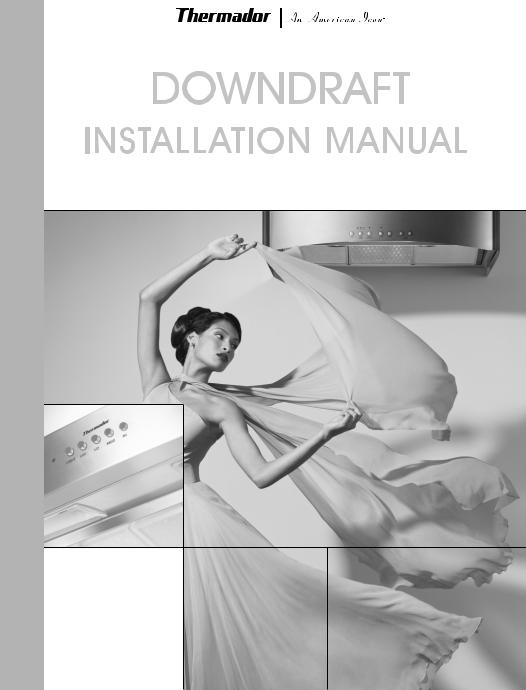
MODEL: UCVM30FS / UCVM36FS
en
fr
page |
03 – 19 |
page |
20 – 36 |
es |
página |
37 – 53 |
2
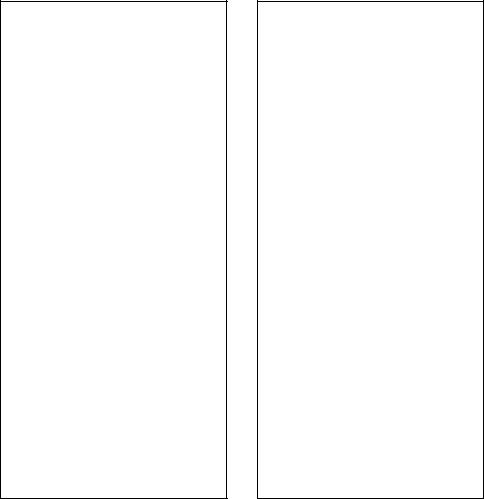
SAFETY INSTRUCTIONS
READ ALL INSTRUCTIONS BEFORE USING THE APPLIANCE.
READ AND SAVE THESE INSTRUCTIONS
WARNING
To reduced the risk of fire, electric shock, or injury to persons, observe the following:
A.Installation work and electrical wiring must be done by qualified person(s) in accordance with all applicable codes and standards, including fire-related construction.
B.Sufficient air is needed for proper combustion and exhausting of gases through the flue (chimney) of fuel burning equipment to prevent backdrafting. Follow the heating equipment manufacturer’s guideline and safety standards such as those published by the National Fired Protection Association (NFPA), and the American Society for Heating, Refrigeration and Air Conditioning Engineers (ASHRAE), and the local code authorities.
C.When cutting or drilling into wall or ceiling, do not damage electrical wiring and other hidden utilities.
D.Ducted fans must always be vented to the outdoors.
E.Always unplug or disconnect the appliance from the power supply before servicing.
F.This unit is designed for indoor use only. Use this unit only in the manner intended by the manufacturer.
This unit is manufactured for indoor use only. Do not use this unit outdoors.
WARNING
For general ventilating use only. Do not use to exhaust hazardous or explosive materials and vapors.
To reduce risk of fire and to properly exhaust air, be sure to duct air outside. Do not vent exhaust air into spaces within walls, ceilings, attics, crawl spaces or garages.
To reduced the risk of fire, use only metal duct work.
To reduce the risk of fire, electric shock and injury to persons, ventilator assemblies. All models must be installed with integral blower, Model VTN600CV2C or remote blowers models VTI610D or VTR630D. Other ventilator blowers cannot be substituted.
To reduce the risk of fire or electric shock, do not use the fan with any solidstate speed control device.
This appliance has been found to be in compliance with UL 507 Standard for Electric Fans and CAN/CSA-22.2 No. 113 Canadian Standard for Fans and Ventilators. It is the responsibility of the owner and the installer to determine if additional requirements or standard apply in specific installation.
3
Parts Needed |
Parts Supplied |
Blower (Remote or Integral) |
Downdraft assembly (1) |
Tape Measure |
#8 Sheetmetal Screws (8) |
Phillips Head Screwdriver |
Blower Cord Strain Relief (1) |
Duct Tape |
Hardware for brackets on vent (2) |
Ductwork (configuration varies |
Remote Blower Pigtail |
depending on location; See pages 7-12 |
|
for further information) |
|
Additional Sheetmetal screws
(as necessary for ductwork installation)
Transition(s) (style varies depending on ductwork)
Transition box for remote blower installations is available as an accessory.
Saw (or equivalent for cutting countertop)
#8 x 1 1/4” Wood Screws (4)
4
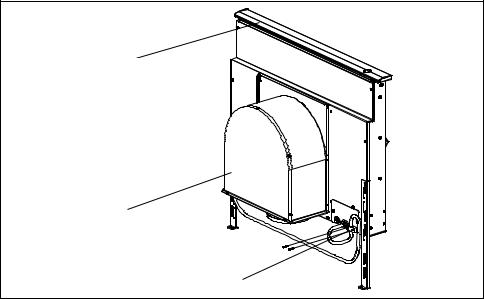
TopT Cap
InternalternalblowerBlow
(Not Included)
(Not Included)
Fig. 1 |
Strain Relief |
|
|
train |
|
|
|
|
INTRODUCTION
GENERAL DESCRIPTION
The complete downdraft system consits of the ventilator, the intake and the blower (See Fig. 1). The blower can be either integral (mounted on the vent intake in the cabinet under the cooktop) or a remote (mounted on the roof or outside wall). When a remote blower is used, a duct transition is mounted on the ventilator intake in place of the integral blower to connect the intake to the ductwork. The duct transition must be purchased separately.
The integral blower or duct transition can be mounted in different positions on the intake to route ductwork to avoid cabinet, building framing, utilities, etc.
The downdraft system is available in 30-inch and 36-inch models. It is intended for use with all brands and models of residential 30-inch or 36-inch gas or electric cooktops except professional style cooktops.
Step 1: Plan the installation
Carefully follow the planning procedures listed below (See Figure 2).
A.Determine whether a remote or integral blower will be used. Remote blower installation requires 4 wires plus a ground wire to run from the downdraft to the blower.
B.Make sure that adequate cabinet and counter space has been provided and that the intake will be accessible if service is required.
C.Consider that cross drafts created by adjacent open windows, doors, air conditioning, old heating vents, recessed ceiling lights, and traffic patterns may affect performance.
D.For gas cooktop installations make sure that a minimum 10 square inch opening is provided in the toe-kick or other cabinet area. Inadequate ventilation of the cabinet below the cooktop may result in flame outage when operating the vent system.
E.Provide for air supply or ”make.up air” to the room where unit will be installed. If ”make-up air” is not provided, then problems, such as fireplace chimney downdrafts, could result.
5
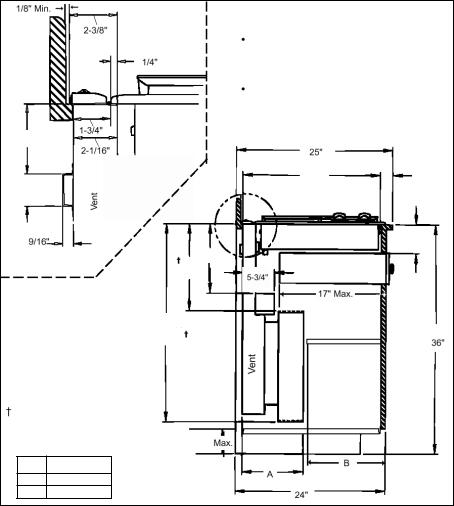
Cooktop
8"
2 1/4"
5 1/2"
6 1/2"
22"
Dimensions are dependent on discharge direction.
14"
Integral/Remote
A 9-13/16"
B13"
Be certain to avoid interference with gas and electric supply to cooktop.
Shelving and drawer depths are dependent upon cooktop depth and setback.
Cutout |
|
Depth |
SB (see |
|
|
|
Fig. 7,8) |
Cooktop
Drawer
Shelving must
be removable
Fig. 2
F.Investigate potential ductwork routes and choose the shortest possible route from the unit to an outside wall or to the roof via an inside wall and attic. For duidance, typical ducting installations are shown in figures 3 through 6. Installation in island locations will require under floor ducting. Peninsula locations usually require ducting laterally through cabinets or under cabinet toespaces. Consider potential interferences to ductwork from building framing (floor joists, wall studs, etc.) and utilities (electrical wiring, water, gas, or sewer lines, etc).
G.Determine whether the chosen route of ducting will meet vent system performance requirements. To do this, measure the duct lengths needed and determine specific fittings required. Enter this data in the spaces provided in
Table 1 (see Page 8). In addition, the duct installation guidelines should be followed in developing the ductwork plan.
H.Purchase the necessary ductwork in accordance with the listing developed in G above.
6

Figures 3 through 6 are examples of possible ducting
Remote Blower
Roof Mount Installation
Remote
Blower
Duct Transition Box
Fig. 3
Integral Blower
Through Wall Installation
Integral Blower
Integral Blower
Through Wall Installation
Integral Blower
Wall Cap 1255-1
12" Min.
Ground
Fig. 4
Remote Blower
Through Wall Installations
3-1/4" x 10" or 8" Duct
End Must Be
Closed and
Sealed
Remote Blower |
Duct Transition |
|
Box |
10" Collar
BLOWER ROTATED 90° FOR SIDE
CONNECTION
Fig. 5 |
Fig. 6 |
7
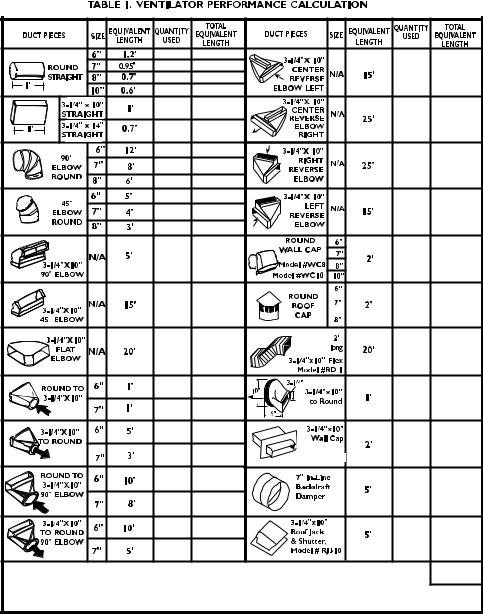
TOTAL (of both columns)= |
8 |
DUCTWORK INSTALLATION GUIDELINES
For safety reasons, ducting should vent directly outdoors (not into an attic, underneath the house, into the garage or into any enclosed space).
Keep duct runs as short and straight as possible.
Duct fittings (elbows and transitions) reduce air flow efficiency.
Back to back elbows and ”S” turns give very poor delivery and are not recommended.
A short straight length of duct at the inlet of the remote blower gives the best delivery.
Transition to duct from the integral blower or remote duct transition as close to the downdraft as is possible. In order of preference, use
1st. 10” round duct 2nd. 8” round duct 3rd. 3-1/4” x 14” duct 4th. 7” round duct 5th. 3-1/4” x 10” duct 6th. 6” round duct
The use of flexible metal round duct should only be used when no other duct fitting exists. Limit use to short lengths and do not crush when making corners.
DUCTWORK INSTALLATION GUIDELINES
Where local codes permit, plastic pipe (PVC-schedule 40 pipe or ABS pipe 7” or 8” diameter) can be used in areas of high ground moisture and in slab floors to eliminate future rusting.
Use only duct work constructed of materials that are acceptable by the applicable codes. All duct should be
26 gauge or heavier to minimize flex due to air flow.
The remote blowers requires a 10” or 8” diameter round duct (depending on model) to match the inlet ring. A transition is necessyary from other duct sizes.
Use sheet metal screws as required to support the duct weight, and seal all joints with duct tape.
Be certain that the duct work does not interfere with floor joists or wall studs.
Do not exhaust more than one vent into a single duct run.
Thermal breaks, such as a short section of nonmetallic duct, should be used in areas of extreme cold.
Always use an appropriate roof or wall-cap with damper. Laundry type wall caps should never be used.
9
Step 2: Prepare Countertop Cutout
For installation with a Bosch cooktop, refer to Part A and Figure 7 (Page 12).
For installation with another brand of cooktop, refer to Part B (Page 13).
For all installations verify that all cutouts will clear the inside of the front countertop support rail, and that the cooktop and vent will be centered left to right within the cutout. Also, make certain that the front and rear cutouts are straight and parallel to the front edge of countertop and the rear backsplash and/or wall. Assure that the side cutouts are square to the front and rear cutouts. All illustrations and dimensions are based on standard 24” deep by 36” high American style base cabinets with 25” countertops.
When installing laminated or solid surface countertops such as Surell™ and Corian®, be sure to follow the countertop manufacturer’s instructions regarding minimum comer radii, reinforcement of corners, etc.
For overhead cabinet and cooktop side clearances consult cooktop Installation Instructions.
A.For installation with a cooktop (Figure 7 and Table 2)
Provide an opening in the countertop as specified in Table 3 (Page 13). Make sure that the distance from the front of the countertop to the front of the cutout is not less than dimension ”SB”. Verify that the available flat countertop is
greater than dimensions “OW” by “OD”. Make certain that the backsplash thickness does not exceed dimension “BT”.
10

TABLE 2: INSTALLATION DIMENSIONS WITH THERMADOR COOKTOP
Cooktop |
CW |
CD |
OW |
OD |
SB |
BT, Max++ |
Model No. |
Cutout |
Cutout |
Overall |
Overall |
Minimum |
Backsplash |
|
Width |
Depth |
Width |
Depth |
Set Back |
Thickness |
|
|
|
|
|
|
|
30” Cooktops: Installed with UCVM30FS
SGS304* |
28-15/16 |
22-1/4 |
31 |
23-3/4 |
1-1/2 |
3/4 |
SGSX304* |
28-15/16 |
22-1/4 |
31 |
23-3/4 |
1-1/2 |
3/4 |
CET304 |
28-3/4 |
22-1/8 |
31 |
23-7/8 |
2-1/2 |
0 |
CEP304 |
28-3/4 |
22-1/8 |
31 |
23-7/8 |
2-1/2 |
0 |
CEM304 |
28-3/4 |
22-1/8 |
31 |
23-7/8 |
2-1/2 |
0 |
|
|
|
|
|
|
|
36” Cooktops: Installed with UCVM36FS
SGS365** |
34-15/16 |
22-1/4 |
37 |
23-3/4 |
1-1/2 |
3/4 |
SGSX365** |
34-15/16 |
22-1/4 |
37 |
23-3/4 |
1-1/2 |
3/4 |
CET365 |
34-3/4 |
22-1/8 |
37 |
23-7/8 |
2-1/2 |
0 |
CEP365 |
34-3/4 |
22-1/8 |
37 |
23-7/8 |
2-1/2 |
0 |
CEM365 |
34-3/4 |
22-1/8 |
37 |
23-7/8 |
2-1/2 |
0 |
|
|
|
|
|
|
|
Notes
*Dimension ”SB” is the minimum distance from the leading edge of the counter to the leading edge of the cutout.
++Dimension ”BT” is the thickness of backsplash that provides 1/4” clearance between vent and backsplash. Any backsplash with a curved radius where it meets the counter will require additional clearance. Thicker backsplashes may be used by increasing the counter and cabinet depths.
All dimensions are in inches and are based upon a standard 24” deep base cabinet with 25” countertop.
** SGS and SGSX: width in table is at the widest point (center).
Refer to cooktop Installation Instructions for complete information prior to making any cutouts.
Clearance is provided to allow raising of the hinged main top.
11
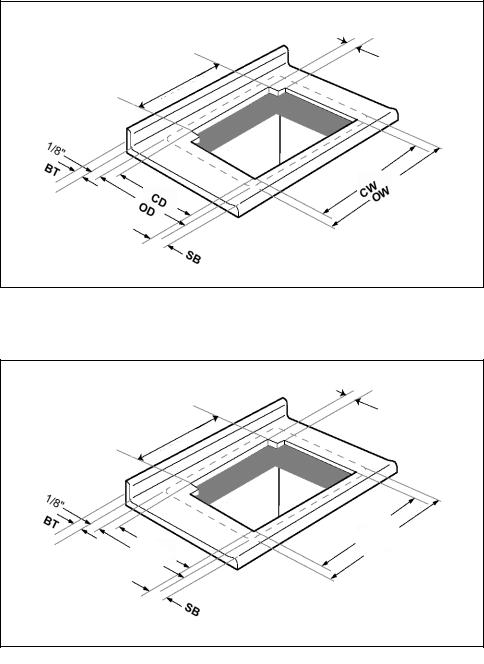
INSTALLATION WITH COOKTOPS WHEN SPECIFIED
|
: |
3/8" |
|
|
|
3/8" |
|
|
34 |
|
|
36" |
28 |
|
|
: |
|
|
|
30" |
|
|
|
2 1/4"
Fig. 7
INSTALLATION WITH OTHER COOKTOPS WHERE SPECIFIED
|
: |
3/8" |
|
|
|
3/8" |
|
|
34 |
|
|
36" |
28 |
|
|
: |
|
|
|
30" |
|
|
|
CCD
COD
Fig. 8
2 1/4"
12
B. FOR INSTALLATION WITH ANOTHER BRAND OF COOKTOP (Figure 8)
Have the following cooktop measurements available before proceeding All cooktop dimensions should be verified through measurement prior to cutting the countertop:
CCW = Cooktop Cutout Width
CCD = Cooktop Cutout Depth
COW = Cooktop Oberall Width
COD = Cooktop Oberall Depth
with the above dimensions confirmed, determine the cutout size as follows:
1. Find the cutout width, (CW):
If CCW is smaller than the cutout width then:
Width |
CW |
|
|
30” |
283/8 |
|
|
36” |
343/8 |
|
|
If CCW is larger than the cutout width then:
CW = CCW
See Figure 8 for cutout widths and dimension definations.
2.Calculate the cutout depth, CD:
Determine the cooktop overhang (CO)
CO = (COD-CCD)/2 (Assumes front and rear cooktop overhangs are equal). Calculate the cutout depth, (CD):
CD = COD - CO+1-7/8”
3.Determine setback (SB) distance from front of countertop to front of cutout.
SB is specified in the installation instructions shipped with the cooktop.
4.Backsplash thickness must not exceed BT as calculated below:
BT = 24 7/8” - OD-SB+CO
(Provides 1/8” clearance between vent and backsplash.) A negative value for BT means countertop is too small for the installation.
5.Verify that the available flat countertop has a width greater than OW and a depth greater than OD.
OW depends on the installation:
Width 30”: OW equals the greater of COW or 31”.
Width 36”: OW equals the greater of COW or 37”.
OD is determined by: OD = COD + 21/8”.
6.Cut countertop using dims: CD, CW and SB as defined in Figure 8.
13

Point "P" (Center of Rear Cut-line)
Countertop
Surface
Right Side
Cabinet Back
Left Side
Plumb line to intersection A-A & B-B
Receptacle
Location
|
|
|
|
|
|
|
|
|
|
|
|
|
|
|
|
|
|
|
|
|
|
|
|
|
|
|
|
|
|
|
|
|
Adjustable |
|
|
|
|
|
|
|
|
|
|
|
|
|
|
|
|
|
|
|
|
|
|
|
|
|
|
|
|
||
Note: Centerlines of |
Within Range |
|
|
|
|
|
|
|
|
|
|
|
|
|
|
|
|
||||||||||||||
|
|
|
|
|
|
|
|
|
|
|
|
|
|
|
|
Rectangular Duct Shown |
|
|
|
E Cabinet Bottom Shelf |
|||||||||||
|
|
|
|
||||||||||||
Fig. 9
Cabinet Cutout Dimensions for Blower:
C |
D |
E |
F |
G |
|
|
|
|
|
6 3/8” |
14 1/2” |
1 7/8” |
15 1/2” |
9 3/4” |
|
|
|
|
|
Table 4
Step 3: Prepare Duct Cutouts in
Cabinet
A.Refer to Figure 9. Drop a plumb-line from Point ”P” at the rear center of the countertop cutout. Mark this point on the bottom of the cabinet below. Construct two reference lines through this point: one should be parallel to the cabinet front and directly below the rear countertop cutout (Line A-A), and the other (Line B-B) should be at right angles to A-A.
B.Using these reference lines as a base for the measurements shown in Table 4, layout the necessary cabinet cutouts needed to implement the planned ductwork route. Where a range of measurements is noted, choose a measurement that allows best clearance from wall studs, floor joists, utilities, or other obstructions.
Step 3: Prepare Duct Cutouts in
Step 3: Cabinet
C.Temporarily set intake and cooktop in place and attach integral blower (or duct transition fitting if a remote blower is installed). Refer to steps 6 and 7. Verify that the duct cutouts as marked will match the hardware installation. Adjust the duct cutout as necessary to match hardware installation.
D.Remove temporarily placed hardware and make cutouts in cabinet to accommodate ductwork installation.
E.Make all other cabinet modifications needed to provide proper clearances for drawers or removable shelving.
14
Step 4: Install Ductwork (Remote
Blower, If Used)
A.Install the ductwork and remote blower (if used) in accordance with the ductwork routing plan developed in Step 1.
B.Make sure that the installation complies with all installations guidelines. Also check that the opening where duct passes through outside wall or roof has been properly flashed and sealed to prevent leakage.
C.If using Integral Blower, Model VTN600CV2C, proceed to Step 5.
D.If using Remote Blower Model VTI610D or VTR630D, refer to Installation Instructions with that model.
Step 5: Install Electrical Service
Check your local building codes for proper method of installation. In the U.S., if there are no applicable local codes, this unit should be installed in accordance with the National Electric Code ANSI/NFPA No. 70, Current Issue. (In Canada, installation must be in accordance with the CAN 1-B149.1 and .2-Installation Codes for Gas Burning Appliances and/or lodal codes).
The appliance must be grounded. In the event of an electrical short circuit, grounding reduces the risk of electric shock by providing an escape wire for the
electric current. This appliance is equipped with a cord having a grounding wire with a grounding plug. The plug must be plugged into an outlet that is properly installed and grounded.
WARNING – Improper grounding can result in a risk of electric shock.
Consult a qualified electrician if the grounding instructions are not completely understood, or if doubt exists as to whether the appliance is properly grounded.
Do not use an extension cord. If the power supply cord is too short, have a qualified electrician install an outlet near the appliance.
The receptacle should be located under the countertop so that the 30 inch long power cord from the vent will reach it.
See Figure 9. The cord should be routed beneath the appliance and away from heat generated by the cooktop. Access should not be obstructed by blower, cabinet work, ductwork or electrical/gas utilities for the cooktop. All power for the vent system (including the remote blower, if used) is supplied via the cord to the intake unit. The outlet can usually be extended from another kitchen outlet or have its own circuit from the main service panel.
Do not plug vent cord into receptacle until Step 8.
Step 6: Mount Vent and Cooktop
A.Remove grease filters and any packing materials from inside the intake.
B.Set the vent intake into rear of countertop opening. Carefully lower it into position so that the flanges on the rear sides and edges fully support the unit hanging from the coluntertop.
C.Hold the unit against the rear of the countertop opening, and slide the leg brackets down to meet the bottom of cabinet. Check and adjust for plumb, then fasten leg brackets to cabinet with hardware provided.
D.Place the cooktop in countertop opening with the rear edge of cooktop overlapping the front edge of the vent.
Make sure rear edge of cooktop does not bind against front of snorkel.
Follow the manufacturer’s installation instructions for installing gasket strips, protective heat tape (if required), securing the cooktop to the countertop and making the cooktop electrical and/or gas connections.
15
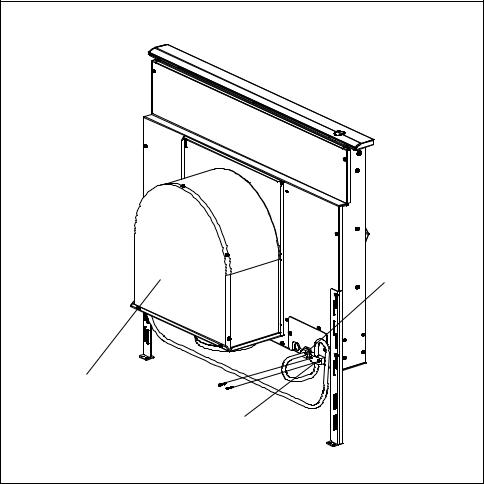
Step 7: Mount Integral Blower or Outlet Duct Transition for Remote Blower
Integral Blower (see Figures 10 and 12 for further detail):
A.Attach blower in front of round exhaust outlet with 4-6 (depending on configuration) #8 sheetmetal screws.
B.Feed cord from blower through strain relief.
C.Secure strain relief with screws.
Step 7: Mount Integral Blower or Outlet Duct Transition for Remote Blower
Integral Blower VTN600CV2C (see Figures 10 and 12 for further detail):
D.Attach strain relief to downdraft near junction box.
E.Connect cord to downdraft at 6 pin connector.
F.Connect blower to ductwork.
6 Pin
Connector
Internal Blower
Strain Relief
Fig. 10 – Internal Blower
16
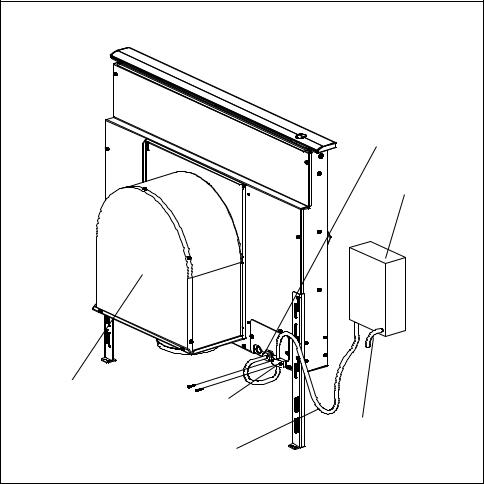
Remote Blower (see Figures 11 and 12 for further detail):
A.Remove junction box cover and connect conduit with 5 wires from remote blower. Hook up wires per Wiring Diagramm.
Fig. 10. Replace junction box cover.
B.Attach duct transition at mounting holes with sheetmetal screws.
C.Feed remote blower pigtail through strain relief.
D.Attach strain relief to downdraft near junction box.
Integral Blower VTN600CV2C (see Figures 10 and 12 for further detail):
E.Connect pigtail to downdraft at 6 pin connector.
F.Run pigtail wires to juntion box.
G.Inside junction box, connect conduit with five wires from remote blower. Use a conduit connector to secure.
Note: Blower and duct transition box may be installed with duct outlet left, down or right. Install blower or duct transition in such a way that access panels can be removed for service.
gure 11 - Remote Blower
6 Pin Connector
Junction Box
TTransition |
|
|
CV2T6DHZDHR6 |
Strain Relief |
|
|
Remote Blower |
Conduit To |
|
Pigtail |
Remote Blower |
Fig. 11 – Remote Blower |
|
|
17
